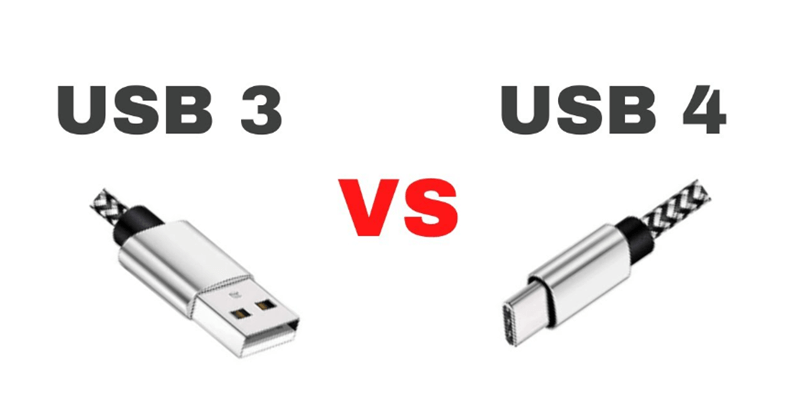Quick Navigation:
With each new version of the USB standard, digital communication has changed because of new technologies. USB4 is the latest idea that promises to completely change how data is transferred and how products work together.
In contrast to USB 3, USB 4 requires a flexible USB-C connector, which improves connectivity and makes things easier for users. As the potential maximum transfer speed increases by a factor of ten, it puts USB4 in a league of its own, far ahead of the fastest version of USB 3. Since it was first created in 1996, USB has undergone many changes and is now a standard part of all modern gadgets.
However, with each new specification, it might be hard for casual viewers to see how the improvements work. In this article, we'll discuss the secrets of USB4, figuring out how it will change things and how it's an improvement over USB 3.

USB3 VS. USB4
The most recent version of the Universal Serial Bus standard is USB4. It is built on the Thunderbolt 3 standard, which Intel made public that same year for free. Because of this, Thunderbolt 4 and USB4 are a lot alike.
It requires the USB-C connector and makes many changes, like making it easier to name products and transferring data faster. The Universal Serial Bus standard has three main versions.
The third one is USB 3, also called "Super Speed." The first USB 3.0 protocol came out in November 2008. Since then, USB 3.1 (2013) and USB 3.2 (2017) have been released to replace it.
1. Transfer Speed
It's no surprise that USB4 can transfer info faster than USB3. The fastest version of USB 3, USB 3.2 Gen 2x2, can go as fast as 20 Gbps, which is the slowest speed that USB4 can give. With USB4 2.0, you can send data at speeds of up to 120Gbps.
Data tunneling is another new feature in USB4. It lets more than one data and displays protocol effectively using the available bus bandwidth. Even if the speed is the same as that of USB 3.2, it could be faster to send mixed data.
2. Types of Connectors Supported
The USB Type-C port is required for USB4 to work. It is the first major USB standard to do so. That is why you can't get USB4 transfer speeds with any other connection than a USB C-to-C one.
However, the USB 3.2 standard doesn't say you must use a single connector. Instead, it works with four different USB plugs and sockets: SuperSpeed Type-A (which has five more pins than USB 2.0), SuperSpeed Type-B, USB 3.0 Micro-B, and USB-C. In general, this is true, but for USB 3.2 Gen 1 x 2 and Gen 2 x 2 to work with multiple lanes, they need fully featured USB C-to-C connections.
3. Compatibility
It is important for the USB standard that updated versions can work with older ones, and this is how it should be. It doesn't always mean actual compatibility since some USB connectors are only meant to work with certain types of USB ports and won't fit into others.
Instead, it means that two USB devices of the same generation can always talk to each other once they are physically linked. Because of this, USB 3 and USB 4 can work with older standards. USB4 adds Thunderbolt 3 compatibility, but it's mostly an extra function.
4. Performance and Cost
Because USB4 is newer and has more complicated features, cables and devices that support it will cost more than those that support USB 3. However, USB4 is expected to get cheaper over time as it is used by more people and the cost of making it will decrease.
For those on a tight budget, USB 3 is the best choice because it offers good performance at a lower cost. USB 3 will appeal to people who want a cheap way to meet their basic connection needs. USB4, on the other hand, will be better for games, video editors, and other power users.
5. Power Delivery
The first Power Delivery standard, USB PD 1.0, had six set power profiles that could deliver up to 100W. Power Delivery 2.0 made the rules more flexible, and USB PD 3.1 raised the highest power that can be sent through a USB cable to 240W.
Power Delivery is a function of the USB-C connector, not the protocol. This means that USB4 and USB3 can send up to 240W of power. To get the most out of USB PD, you only need a good USB C-to-C cable with all your features.
Conclusion:
In conclusion, USB4's release is a big deal in digital connectivity; it offers faster speeds and more flexibility than USB 3. With a theoretical top speed of 120Gbps and the need for a USB-C connector, USB4 sets a new bar for how quickly and efficiently data can be sent.
While USB 3 is still a good option for people looking for cheap ways to connect, USB4's advanced features make it better for power users, gamers, and workers who need to send and receive data quickly.
If you want to clone all data from a USB 3 device to a new USB 4 device, just use disk cloning software - such as DoYourClone to quickly move all data from the old device to the new device.